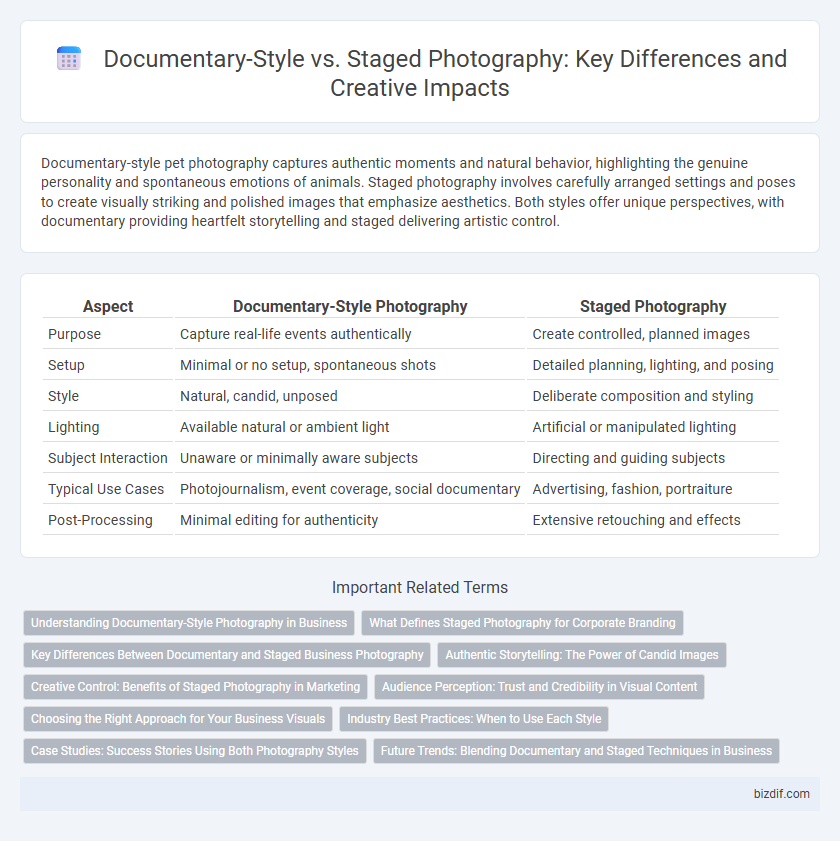Documentary-style pet photography captures authentic moments and natural behavior, highlighting the genuine personality and spontaneous emotions of animals. Staged photography involves carefully arranged settings and poses to create visually striking and polished images that emphasize aesthetics. Both styles offer unique perspectives, with documentary providing heartfelt storytelling and staged delivering artistic control.
Table of Comparison
| Aspect | Documentary-Style Photography | Staged Photography |
|---|---|---|
| Purpose | Capture real-life events authentically | Create controlled, planned images |
| Setup | Minimal or no setup, spontaneous shots | Detailed planning, lighting, and posing |
| Style | Natural, candid, unposed | Deliberate composition and styling |
| Lighting | Available natural or ambient light | Artificial or manipulated lighting |
| Subject Interaction | Unaware or minimally aware subjects | Directing and guiding subjects |
| Typical Use Cases | Photojournalism, event coverage, social documentary | Advertising, fashion, portraiture |
| Post-Processing | Minimal editing for authenticity | Extensive retouching and effects |
Understanding Documentary-Style Photography in Business
Documentary-style photography captures authentic, candid moments that reflect genuine interactions and real-life environments, making it ideal for businesses aiming to build trust and showcase transparency. This approach highlights natural lighting, unposed subjects, and spontaneous events, effectively conveying a brand's story and corporate culture. Emphasizing authenticity, documentary photography enhances audience engagement by providing relatable, truthful visual narratives that resonate with customers.
What Defines Staged Photography for Corporate Branding
Staged photography for corporate branding involves meticulously planned and arranged scenes that convey specific brand messages, values, and aesthetics through controlled lighting, props, and composition. This style prioritizes visual consistency and professionalism to strengthen brand identity and appeal to target audiences. Unlike documentary-style photography, staged images are carefully directed to evoke desired emotions and reinforce corporate narratives.
Key Differences Between Documentary and Staged Business Photography
Documentary-style business photography captures authentic, unscripted moments, emphasizing real interactions and natural environments to convey genuine brand stories. Staged business photography involves carefully planned setups with controlled lighting, posed subjects, and specific props to create polished, idealized images. The key difference lies in the approach: documentary photography prioritizes spontaneity and realism, while staged photography focuses on intentional composition and refined aesthetics for marketing purposes.
Authentic Storytelling: The Power of Candid Images
Documentary-style photography captures raw, unposed moments that convey genuine emotions and authentic stories, making each image a powerful narrative tool. Candid images reveal the true essence of subjects by preserving spontaneous interactions and natural expressions, fostering deeper viewer connections. In contrast, staged photography, while visually controlled and polished, often lacks the emotional depth and immediacy that documentary-style photography inherently provides.
Creative Control: Benefits of Staged Photography in Marketing
Staged photography offers marketers precise creative control, enabling tailored visuals that align perfectly with brand messaging and campaign goals. This method allows for meticulous arrangement of elements such as lighting, props, and models, resulting in consistent, high-impact images that resonate with target audiences. The ability to direct every aspect of the scene enhances storytelling effectiveness, making staged photography a powerful tool in marketing strategies.
Audience Perception: Trust and Credibility in Visual Content
Documentary-style photography enhances audience trust by capturing candid, unaltered moments that convey authenticity and raw emotion. In contrast, staged photography may evoke skepticism due to its orchestrated nature, potentially impacting perceived credibility. Audience perception tends to favor documentary visuals for truthful storytelling, reinforcing the importance of genuine representation in visual content.
Choosing the Right Approach for Your Business Visuals
Selecting the right photography approach for your business visuals depends on the message and authenticity you want to convey. Documentary-style photography captures candid, real-life moments that build trust and relatability with your audience, ideal for brands emphasizing transparency. Staged photography offers controlled composition and polished aesthetics, perfect for showcasing products or services with precision and consistency.
Industry Best Practices: When to Use Each Style
Documentary-style photography excels in capturing authentic moments and real emotions, making it ideal for photojournalism, event coverage, and storytelling projects where naturalism is paramount. Staged photography, preferred in commercial shoots, fashion, and advertising, allows meticulous control over lighting, composition, and subject positioning to create polished, visually compelling images. Industry best practices recommend choosing documentary-style for candid authenticity and staged photography when precise visual narratives or brand messaging need to be constructed.
Case Studies: Success Stories Using Both Photography Styles
Case studies demonstrate that documentary-style photography excels in capturing authentic moments, as evidenced by projects like Steve McCurry's iconic "Afghan Girl," which reveals raw human emotion and cultural context. Conversely, staged photography achieves success in fashion advertising campaigns such as Annie Leibovitz's portrait sessions, where meticulous planning and creative direction create visually compelling narratives. Combining both styles in editorial work allows photographers to balance genuine storytelling with artistic control, leading to impactful and memorable images.
Future Trends: Blending Documentary and Staged Techniques in Business
Future trends in photography highlight a fusion of documentary-style authenticity with staged precision, creating compelling narratives that resonate deeply with audiences. Businesses increasingly adopt this hybrid approach to produce content that combines the raw emotions of real moments with the control and clarity of planned compositions. This blend enhances brand storytelling, offering visually engaging and credible imagery that drives stronger customer connections and market impact.
Documentary-Style vs Staged Photography Infographic

 bizdif.com
bizdif.com